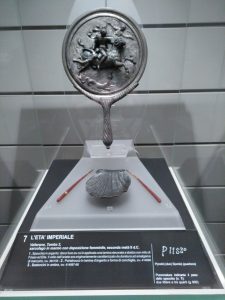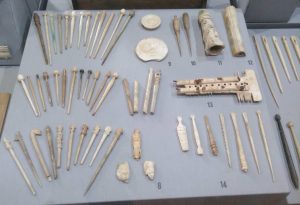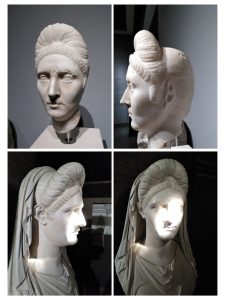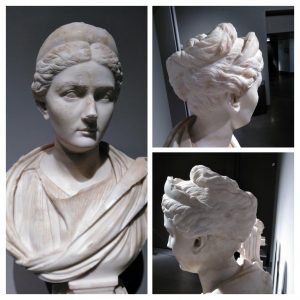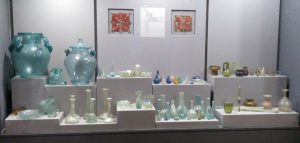This month’s post has been written by Brittany Stone, a M.A. student in Roman History and Archaeology at the University of Kent.
Throughout the centuries, some of our habits have changed and others have remained surprisingly similar. The routine of getting ready for the day (waking up in the morning, getting out of bed, checking the mirror, etc.) is a process that is relatable across cultures and time periods. For many women (past and present), trying to look their best is done through elaborate makeup patterns and complex hairstyles. However, in some cultures and eras, this personal treatment was actually harmful. In Roman times, elaborate hairstyles could take hours and makeup could be poisonous. So why would Roman women go through this long, complex and often painful process of beautification?
Figure 1: Bronze mirror from the Palazzo Massimo.
Unfortunately, there is not a lot of evidence to rely on for ancient women in general and in particular for the process of hair and makeup. Thanks to archaeology, we have discovered bronze mirrors, glass jars used for either makeup or medicine, sometimes even poisons (sometimes there was no distinction between the two) and ancient hair combs made from animal bones. The greatest evidence of female enhancement is to be observed in the visual arts: portraits of wealthy Roman women through the medium of paintings, statue busts, and coins.
Figure 2: Coins from the Palazzo Massimo.
Literary sources portray a different version of reality. Usually, these ancient pieces of evidence would be an asset, but the most renowned ancient writers were mainly men and many literate Roman men had a negative view of women. A few wrote on female embellishment, although with a hint of bias. In Roman society, men and women viewed artificial beauty in different and conflicting ways. To some men, elaborate hairstyles and makeup were seen as a vile waste of time, against Roman values, and a dishonest way for women to hide their true selves (which sounds remarkable modern). According to Ovid (Ars Amatoria 3.217-218), a woman must never allow a man to see her while getting ready because the disgusting process took away from the beauty of the final product. Based on Ovid’s instructions, women were to keep their beauty products away from the male gaze and behind closed doors like a shameful secret. These male-biased depictions of make-up and their prejudices regarding the sort of women who wore it, do not represent the views of everyone. As archaeological evidence shows it, female beautification was a common phenomenon. The tools for makeup and hairdressing have been found in many wealthy Roman houses.
Figure 3: Hair pins and combs at the Palazzo Altemps.
So how did Roman women execute impressive hairstyles and makeup? First of all, in the way of hairdressing as it was restricted to the wealthy classes. According to the tradition, complex hairstyles were the norm for wealthy patrician women as they had the means and the time for lengthy hair sessions. It was standard for household slaves to know how to create fantastic hairstyles and some impressive designs required a team of servants. Even with the most outlandish hairstyles, most of the Roman hairstyles used the wearer’s natural hair. However, without modern hairspray, hairstyles were kept in place by hairpins and, surprisingly, sewing the hair in place. Many of these impressive hairstyles cannot be replicated today (although some people have reconstructed certain styles).
Figure 4: Plotina, wife of Emperor Trajan, top from the Palazzo Massimo, bottom from the Museum of the Imperial Forums.
Figure 5: Sabina, wife of Emperor Hadrian, from the Palazzo Massimo.
To see a hairstyle reconstruction from the bust of Empress Sabina, wife of Hadrian, view this link.
When it came to hair, the Romans preferred to be as natural as possible (colour-wise, if not style-wise), viewing long thick hair as the most valuable and beautiful. The ability to pull off complex hairstyles using natural hair was the most impressive. When a woman’s hair was not strong enough or long enough for this, women resorted to waxes, dyes and wigs to complete elaborate Roman hairstyles. However, Roman society looked down on wigs and dyes as they were seen as a means of covering up a disfigurement, such as hair loss in the elderly. A documented incidence of ancient hair dye is the use of henna to temporarily darken and thicken the hair but this is not a common phenomenon. To the Romans, colour does not seem to be much of a sought-after commodity, as they did not seek ways to change their natural hair colour. When wigs were created (and became more popular later in history), the Roman Empire’s large territorial span made a trade of all hair colours possible, from thick black Indian hair to the blond hair of the German tribes, the so-called “captured hair” resulting from spoils of war.
On the other hand, some Roman women never changed their hair. Instead of constantly seeking crazier styles, they made a statement with simpler hairstyles. Famously, Livia, wife of Augustus, used her rather plain hairstyles as a symbol of Republican traditions during the transition from Republican to Imperial rule. However, as can be observed on her statue bust, Livia’s ‘simple’ chignon still required a distinctive twist that must have necessitate a lot of work in the morning.
Figure 6: Livia, wife of Emperor Augustus, from the Ara Pacis.
Unlike the elaborate hairstyles of the wealthiest matronae, women of lower-classes could own makeup and perfumes as they were widely available and the containers to hold them (whether glass or wooden boxes) were cheap. Interestingly, the Latin term for ‘cosmetics’ (medicamentum/medicamen) had other meanings that provide various understanding for its use in antiquity. Medicamentum/medicamen also designates an artificial means of improving, a wash, a remedy, or a poison; which relates to every way cosmetics were used in Roman society. Furthermore, there was no such thing as a cosmetic on its own. It was viewed as a property of medicine, poison, and even magic because they were all defined by the same understanding: as a craft or skill for having a certain control over the body. Women having the ability to beautify and make the face better was mystifying to men, it was seen as magical and something they did not understand.
There were multiple and various kinds of cosmetics that Roman women had at their disposal. Face creams are likely to have been desirable throughout history, since diseases ravaged the skin and poor hygiene took its toll. One miracle ingredient, still hailed for its medicinal properties today, was honey. Its properties were apparently used at its best when mixed with other products such as lentil, iris, or rue and there are ancient recipes for disguising scars, removing pimples and hiding spots and freckles. Along with clean skin, Roman women preferred a paler complexion as this showed that they did not have to work outdoors in the sun, and they used face whitening creams made from rather dangerous materials. The most popular face whitening cream was cerussa (sugar of lead) which was made by pouring vinegar over white lead shavings and letting the lead dissolve and dry to be ground and formed into tablets. Modern scientists know that lead is poisonous to the human body but the ancients knew its dangerous effects as well. As a safer alternative to white lead, women were mixing chalk with vinegar, which ironically contributed to worsening their skin complexion.
Ancient sources written by men, which tend to be critical of women, claimed that Roman women had another facial whitener which was made out of crocodilea, the dung of crocodiles. These ancient writers talked of crocodilea as a way of judging women for using animal dung as a facial. However, the term may have been borrowed from the Egyptian language to refer to Ethiopian earth, as its particular soil was prized for cosmetics, meaning that crocodilea was a mud mask instead of being made of animal droppings. Another application for this popular substance was as a form of blush. In terms of makeup, ancient Roman women had blush, eyeshadow (green or black), eyeliner (applied with a stick or needle made of either wood, glass, bone or ivory), but there is no mention of them colouring their lips or using lipstick.
Figure 7: Glass jars and containers from the Palazzo Altemps.
Looking at ancient art, Roman women were not represented in mosaics and frescos in a natural light, which is rather different to what ancient male authors describe in their dramatic portrayal of ancient female cosmetics. On the contrary, these exact cosmetics were used by ancient artists to capture the world. Soot and ash, used as ancient eyeliner, were also employed for frescos; white lead and elements of rouge were used to create paint, and chalk was a mixing agent for more vibrant, artificial colours. From this perspective, we can clearly understand how the ancient Roman woman “literally constructed herself as an art object using even the same materials as artists” (Olson 2009, 309).
When getting ready in the morning, when brushing the hair and washing the face, the differences between now and then are obvious. Women no longer sew their hair in place or cover their faces in lead or animal dung. But take a moment and wonder, what part of your morning routine may seem ridiculous in the future?
Further Reading:
- Bartman, E. 2001. ‘Hair and the Artifice of Roman Female Adornment,’ American Journal of Archaeology, Vol. 105, No. 1, 1–25. JSTOR
- Evans M. and Evans L. 1906. ‘Hair-dressing of Roman ladies as illustrated on coins,’ The Numismatic Chronicle and Journal of the Royal Numismatic Society, Vol. 6, 37–65. JSTOR
- Stephens, J. 2008. ‘Ancient Roman Hairdressing: on (Hair)Pins and Needles,’ Journal of Roman Archaeology, Vol. 21 110-132.
- Olson, K. 2009. ‘Cosmetics in Roman Antiquity: Substance, Remedy, Poison,’ The Classical World, Vol. 102, No. 3, 291–310. JSTOR
